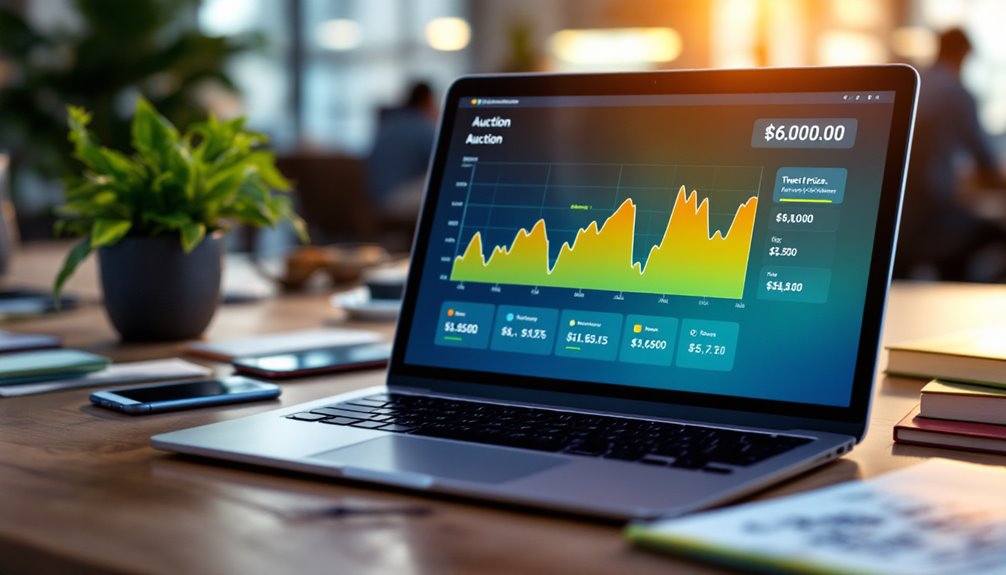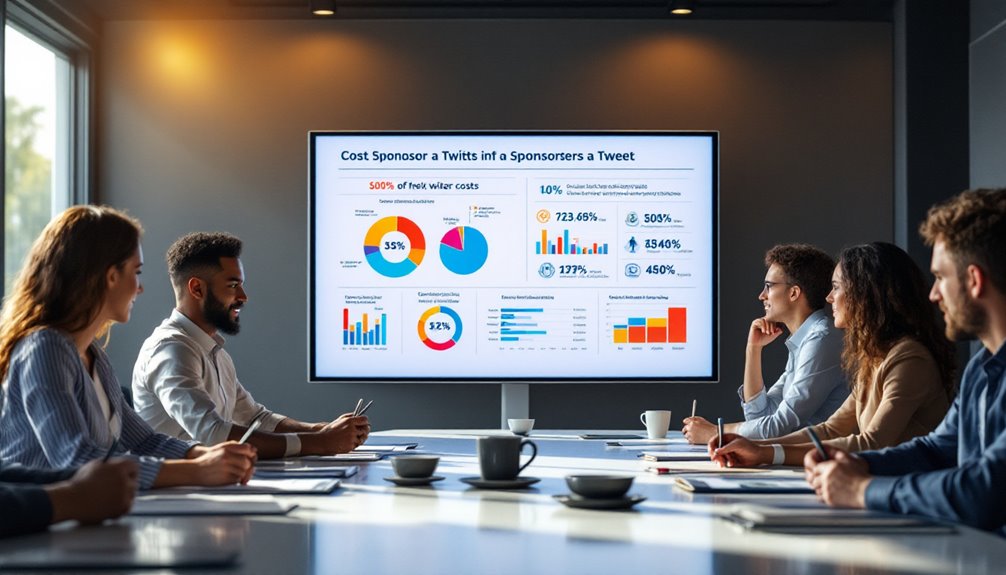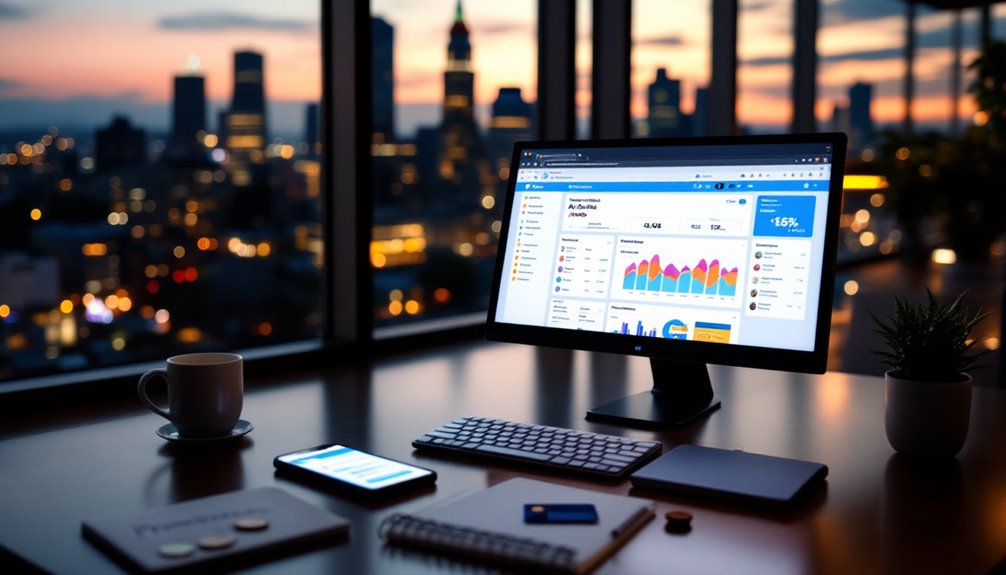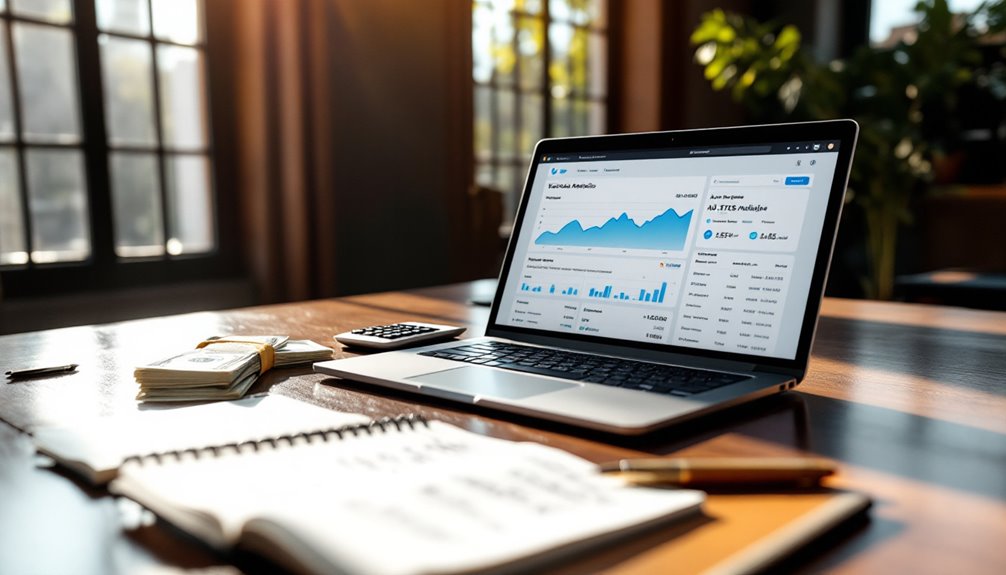
How much does it cost to sponsor a tweet?
When you’re considering enhancing your digital footprint through Twitter, the cost to sponsor a tweet may not break the bank but it’s not pocket change either. You’re looking at a range of $0.50 to $2.00 per action, depending on your strategy. But how do these numbers translate into your specific goals? Understanding the intricacies of Twitter’s auction system and the factors that influence ad costs can be the difference between a successful campaign and wasted budget. Are you curious about maximizing your ad spend while ensuring peak engagement? Let’s explore the nuances of sponsored tweets.
Key Takeaways
- Promoted tweets typically cost between $0.50 and $2.00 per action.
- The average cost for a promoted tweet is approximately $1.35.
- Costs vary based on audience targeting and ad competition.
- Bidding strategies influence the final cost of a sponsored tweet.
- Promoted tweets are generally more affordable than promoted accounts or trends.
Understanding Twitter Ad Types

In today’s digital marketing landscape, understanding Twitter ad types is essential for maximizing the platform’s potential.
Twitter Ad Formats like Promoted Ads, Follower Ads, Amplify, and Takeover Ads offer diverse ways to engage your audience effectively.
With Promoted Ads, you can reach those who aren’t yet followers by using a variety of media formats such as text, images, or videos. These ads are clearly marked to distinguish them from organic content, allowing for authentic audience engagement through likes, retweets, and comments.
Follower Ads are perfect if you’re aiming to grow your audience. They strategically appear in the “Who to follow” section, targeting users likely to be interested in your brand. This form of Audience Targeting helps bolster your Twitter presence efficiently.
For a more dynamic approach, consider Twitter Amplify and Takeover Ads. Amplify lets you serve ads through video content, while Takeover Ads provide exclusive access to premium spaces, such as trending topics. Twitter ranks as the top platform for brand interactions, making these ad formats especially effective for reaching a wide audience.
These innovative formats guarantee your brand remains at the forefront of user engagement.
Lastly, Branded Hashtags and other specialized ad formats enhance your campaign’s visibility, using strategic Audience Targeting and tailored bidding models to align with your objectives.
Promoted Tweets Cost Breakdown
Maneuvering the cost landscape of Promoted Tweets requires a strategic approach to maximize your advertising budget. Promoted tweet pricing ranges from $0.50 to $2.00 per action, with an average of $1.35. Understanding these figures helps you devise effective ad engagement strategies.
The cost you incur depends on the quality and relevance of your ads to your target audience, and your chosen bidding strategy. Since advertisers are only charged when someone interacts with their ad, you’re looking at a cost-effective way to drive engagement.
The auction system plays an essential role in determining costs. Your bid should be competitive, but you’ll only pay slightly more than the next highest bidder. This structure emphasizes the importance of having a well-thought-out bidding model, whether it be CPE (cost per engagement), CPC (cost per click), or CPM (cost per thousand impressions). Each affects the cost differently based on your campaign’s objectives. For instance, Promoted Trends cost approximately $200,000 per day, which makes them a significantly higher investment compared to other ad types.
Compared to other ad types, promoted tweets offer a more cost-effective option, especially for engagement and link clicks. Unlike promoted accounts or trends, which can be considerably pricier, promoted tweets allow for innovation and adaptability within your budget.
How Auction System Works

Understanding the cost dynamics of Promoted Tweets naturally leads us to explore the auction system that governs ad placements on Twitter. At the heart of this system is real-time bidding, where advertisers compete for ad space in mere milliseconds. This rapid-fire process guarantees that only the most relevant and engaging ads capture users’ attention. However, it’s not just about throwing money into the mix. Twitter employs a second price auction model, meaning that while you might win the bid, you don’t pay your full bid amount. Instead, you pay just one penny more than the next highest bid. This encourages strategic bidding, guaranteeing that you’re investing wisely in ad placements. The auction system considers multiple factors beyond just the bid amount. Ad relevance, quality, and user engagement history all play critical roles in determining the auction outcome. This complexity guarantees that ads align with users’ interests, enhancing their overall experience on the platform. Continuous monitoring and optimization of campaigns are essential for maximizing return on investment (ROI), ensuring that advertisers are getting the most out of their bidding strategies.
Factors Affecting Ad Costs
Several key factors can greatly influence the cost of advertising on Twitter, and understanding them is vital for optimizing your ad spend.
First, consider the type of ad you choose. Promoted Tweets, for instance, range from $0.50 to $2.00 per action, while Promoted Trends can soar to $200,000 per day. Each ad format comes with its unique cost structure, influenced by your campaign objectives like website visits or follower growth.
Ad targeting plays an important role. The more precisely you define your audience, the more likely you’re to achieve high audience engagement, which can lower costs. Relevant and well-targeted ads often lead to higher engagement rates, reducing your cost-per-engagement (CPE) and cost-per-click (CPC).
Your bidding strategy also affects costs. Whether you opt for maximum, automatic, or target bidding, strategic choices here can keep expenses in check. Twitter’s auction system considers both bid amounts and ad quality—meaning a high-quality, engaging ad can outshine competitors, even with a lower bid. Ads are placed via the auction system, where the highest bid secures ad placement.
Finally, the competitive landscape and evolving trends can impact prices. Staying adaptable and innovative guarantees your ads remain effective without overspending.
Budgeting for Twitter Ads

When planning your Twitter ad campaign, understanding ad costs and optimizing budget allocation are essential for maximizing your return on investment. You’ll need to decide between setting a total budget for the campaign or managing a daily budget to control spending effectively. Twitter ads in 2025 operate on an auction system, where the highest bids generally win the placement for ad visibility.
Understanding Ad Costs
Steering through the costs of Twitter ads can feel like a puzzle, but with the right approach, you’ll effectively manage your budget and maximize impact. Begin by exploring various ad types and their costs. Promoted Ads cost between $0.25 to $2 per action, while Follower Ads range from $2 to $4 per follow. Tweet Engagements Campaigns and App Installs have their own pricing, from $1.50 to $3.25, and Awareness Campaigns top the range at $6 to $8. The average cost of Twitter ads is influenced by the specific campaign objectives and the actions you are targeting, such as clicks or impressions. To boost ad performance, selecting the correct pricing strategies is vital. Consider the bidding models: Cost-per-engagement lets you pay for interactions like retweets and likes, while Cost-per-click focuses on clicks leading to apps or websites. Cost-per-thousand impressions charges based on ad views. Opt for automatic bidding to let Twitter optimize within your budget, or use manual and target bidding to set specific objectives. Understanding factors influencing costs is fundamental. Your target audience and ad quality greatly impact expenses, as does the competitiveness of bids.
Optimizing Budget Allocation
Optimizing budget allocation for Twitter ads is crucial for maximizing your campaign’s return on investment. Start by carefully setting your budget types: total, daily, or ad group-specific. Each has its advantages, so choose based on your campaign goals. Total budgets cap your spending, while daily budgets guarantee steady engagement. Ad group budgets provide granular control and flexibility, allowing for dynamic budget distribution. Twitter ad costs can vary widely based on several influencing factors, such as campaign objectives, which can dictate different charging methods like cost per action or cost per follow.
Don’t overlook delivery methods. Standard and accelerated options cater to different campaign needs, from consistent exposure to rapid reach in time-sensitive cases. Scheduling ads during peak activity can also stretch your budget further.
Performance monitoring plays a critical role; adjust your strategy in real-time based on Twitter’s automated guidance and your metrics.
Refine your approach by adjusting and optimizing bids. Automatic bidding can maximize results within your budget, while maximum and target bidding offer control over specific objectives. Regularly monitor bid performance and make necessary adjustments to enhance efficiency.
Finally, focus on targeting and creative strategies. Use demographic filters to zero in on the right audience and experiment with engaging content and ad formats. A/B testing helps identify what resonates, guaranteeing every dollar is well spent.
Costs for Promoted Accounts
Understanding the costs for promoted accounts on Twitter is essential for maximizing your social media marketing budget. Promoted accounts offer a strategic approach to follower acquisition and enhancing brand awareness. At a cost of $2-$4 per follower, these campaigns can vary greatly based on your target audience and the duration of your campaign.
Setting a maximum bid allows you to cap costs, giving you control over your spending. Keep in mind, though, that more specific targeting options, like demographics and interests, tend to increase the cost per follower. With over 330 million registered Twitter users, advertisers have a vast audience to reach, making the platform an attractive choice for marketers.
With Twitter’s auction-based bidding system, your costs will depend on the bidding strategy you adopt and the level of competition in your industry. You can opt for automatic bidding to streamline the process, but a strategic maximum bid can help you stay competitive without overspending.
Targeting plays a vital role in the effectiveness of your campaign. By selecting the right audience segments based on their behaviors and interests, you can enhance campaign performance, even if it means higher costs.
Ultimately, gaining new followers and boosting brand awareness are the primary indicators of success, allowing you to track, evaluate, and adjust your strategy as needed.
Analyzing Campaign Objectives

Analyzing campaign objectives is essential for aligning your Twitter marketing efforts with your overall business goals. Understanding the different objectives—Reach, Engagements, Website Traffic, and Keywords—can enhance your campaign performance and improve audience targeting.
The Reach objective maximizes exposure, ideal for boosting brand awareness by minimizing impression duplication and targeting users based on demographics and interests. If your goal is to influence brand perception or announce time-sensitive events, this approach is invaluable.
For those focused on interaction, the Engagements objective encourages users to engage through likes, retweets, and comments. It optimizes delivery to users most likely to engage, fostering conversations and strengthening your brand’s community presence.
If driving website visits is your priority, the Website Traffic objective directs traffic to your site, optimizing for clicks and utilizing Twitter’s Click ID for precise measurement. This is particularly useful for promoting products or generating leads.
Finally, the Keywords objective refines audience targeting by reaching users based on specific keywords they’ve recently engaged with. This allows you to zero in on users with high intent, making it perfect for targeting niche interests or excluding irrelevant audiences. Twitter’s platform is notably cost-effective for ad spend, offering low Cost Per Click rates, which makes it accessible to businesses with varying budgets.
Additional Advertising Costs
When considering additional advertising costs on Twitter, you need to weigh the impact of Promoted Trends pricing against cost per engagement strategies. Promoted Trends can be a costly venture, at $200,000 per day, but they offer massive visibility across the platform. Alternatively, focusing on a cost-per-engagement model allows you to pay only for direct interactions, offering a more controlled approach to budget management. It’s important to note that ad formats impact pricing significantly, with different formats incurring varied costs.
Promoted Trends Pricing
Promoted trends on Twitter offer a powerful spotlight for brands, but they come with a hefty price tag of $200,000 per day. This substantial investment guarantees your brand sits at the top of the trending list for 24 hours, marked with a “Promoted” tag, capturing the attention of millions. While the cost is significant, the potential reach and impact can be invaluable for large enterprises aiming for widespread visibility. For those seeking cost effectiveness, it’s important to weigh this option against other advertising strategies. Promoted trends target a vast audience, making them ideal for brands with a significant following and a desire to make a bold statement. Historically, the cost has surged from $70,000-$80,000 in 2010 to its current price, reflecting Twitter’s growing influence as a marketing platform. Utilizing Twitter Ads Manager allows businesses to manage these campaigns effectively by providing real-time reporting and performance analysis. When considering promoted trends, you’ll need to factor in additional campaign management costs. Whether managed in-house or through an agency, these expenses can range from $650 to $6,000 monthly. It’s vital to plan for ad spend, which varies widely from $200 to $50,000 per month, making sure your strategy aligns with your overall marketing goals and budget constraints.
Cost per Engagement
Understanding the cost per engagement on Twitter is essential for optimizing your advertising strategy. With engagement strategies in mind, let’s dissect how you can achieve cost efficiency.
Promoted Tweets range from $0.50 to $2 per action, while Promoted Accounts can set you back $2 to $4 per follow. Campaign types vary widely, with costs spanning $1.50 to $10 per action, depending on your objectives. Engaging tweets cost between $1.50 and $2.50, whereas app installs or re-engagements demand $1.95 to $3.25 per action.
Bidding strategies play a pivotal role in managing costs. Automatic bidding simplifies but sacrifices control, while maximum bidding lets you cap expenses. Target bidding focuses on specific goals like website visits or followers, and manual bidding offers precision at the expense of complexity.
Factors like ad quality, audience size, and competition influence costs, making strategic targeting vital. The cost of Twitter advertising is further affected by the chosen objective of the campaign, which dictates the bidding strategy and overall expenses.
Don’t overlook additional advertising costs. Consider expenses for campaign management, ad creation, and tracking analytics. These elements, coupled with the auction system’s fluctuating prices, necessitate diligent budget adjustments.
Promoted Trends Pricing

One of the most significant investments you can make on Twitter is in promoted trends, which carry a steep daily cost ranging from $200,000 to $300,000. This pricing strategy reflects their power to captivate a wide audience. Promoted trends appear prominently in the “Trends for you” section, ensuring maximum visibility. They’re perfect for brands looking to spark conversations and extend their reach beyond current followers, targeting specific geographic areas or demographics. Promoted trends are a strategic choice for large brands or events. Their 24-hour duration on the trends list makes them ideal for product launches or major events. This level of exposure doesn’t come cheap, but it does place your brand at the forefront of Twitter’s active community. High competition, especially in sectors like finance and insurance, can drive costs even higher due to the demand for customer leads. The auction system determines the cost, requiring careful budget planning. Twitter provides suggested bids and real-time advice, helping you align your campaign goals with your spend. While the costs are steep, the potential for increased brand visibility and engagement is substantial, making it a worthy consideration for those seeking innovation. The bidding strategy plays a critical role in determining the final cost, as it influences how your ads compete in the auction system.
Key Advertising Metrics
While investing in promoted trends offers immense visibility, understanding the metrics that gauge the effectiveness of your Twitter ad campaigns is equally essential. You’re not just spending on visibility; you’re investing in measurable outcomes.
Key metrics help you assess ad performance by tracking ad clicks, click-through rates (CTR), and link clicks. These indicators reveal how engaging and compelling your content is to your audience. Card engagements provide deeper insights into how users interact with Twitter cards, which can include anything from retweets to favorites. Conversion rates ultimately tell you if these engagements lead to desired actions like sign-ups or purchases.
On the financial side, cost metrics are indispensable. Monitoring ad spend, cost per mille (CPM), and cost per click (CPC) guarantees you know exactly where your money goes. Engagement cost breaks down the total ad expenses by the number of interactions, giving you a clearer picture of financial efficiency. A Twitter Ads dashboard visually displays performance metrics, aiding in assessing campaign effectiveness and optimizing strategies.
An average ROI of 122% highlights the potential profitability of Twitter ads, indicating $1.22 in revenue for every dollar spent. By closely analyzing these metrics, you can make informed decisions, refine strategies, and ultimately drive innovation in your marketing efforts.
Optimizing Ad Spend

To maximize your ad spend on Twitter, start by clearly defining your campaign objectives and understanding your target audience. Experimenting with different ad formats can reveal what resonates most, but don’t forget to leverage Twitter’s analytics to gain insights and refine your strategy. Selecting the right ad format is essential for achieving objectives and enhancing the effectiveness of your campaign.
Define Campaign Objectives
When planning a Twitter ad campaign, defining clear objectives is essential for optimizing ad spend and ensuring success. Establishing specific goals allows you to focus your resources effectively, leading to campaign success and measurable outcomes. With Twitter’s massive user base of 436 million monthly active users, advertisers have the opportunity to reach a broad audience. Whether you’re aiming for maximum reach to enhance brand awareness or seeking to drive website traffic through strategic targeting, clarity in your objectives forms the foundation of a successful campaign.
Start by identifying what you want to achieve. Consider objectives like maximizing reach, boosting engagements, gaining followers, or driving website visits. Each goal requires distinct strategies and impacts your budget differently.
For instance, optimizing for reach demands broad visibility, while driving website traffic necessitates precise targeting and the use of Twitter’s Click ID for accurate measurement.
Tailor your campaign to resonate with your desired audience. Utilize demographic targeting—such as geolocation, age, gender, and language—to reach the right users.
Additionally, strategically targeting keywords relevant to your campaign enhances engagement by connecting with users already interested in similar topics.
Experiment With Formats
Exploring various ad formats on Twitter is key to optimizing your ad spend and achieving your campaign goals. By experimenting with different ad formats, you can tailor your approach to match the preferences and behaviors of your target audience.
Understanding ad format effectiveness is vital for segmentation and ensuring your message resonates with the right people. Whether you’re leveraging the visual allure of image ads or the storytelling power of moment ads, each format offers unique benefits. Twitter users spend 26% more time with ads than on other platforms, which emphasizes the importance of selecting the right format to capture and maintain audience attention.
Consider these ad format variants:
- Promoted Ads: Versatile and can be displayed in users’ feeds, including text, images, videos, carousels, and moments.
- Image Ads: Effective for visual engagement, featuring a single image alongside your tweet content.
- Video Ads: Support videos up to 15 seconds, ideal for dynamic storytelling.
- Carousel Ads: Allow up to six swipeable images or videos, enhancing engagement.
- Moment Ads: Combine tweets to create immersive narratives.
In conjunction with format selection, target audience segmentation elevates your strategy. Use gender, location, and behavioral targeting to refine your reach.
Testing different combinations of ad formats and targeting options is essential. By doing so, you can identify the most cost-effective strategies, optimizing your budget for maximum impact.
Leverage Analytics Insights
Harnessing the power of analytics transforms your Twitter ad strategy from guesswork to precision. By diving deep into audience segmentation, you can uncover who exactly interacts with your ads. Analyzing demographics and interests lets you tailor your campaigns to resonate with specific groups, guaranteeing your message reaches those most likely to engage. Understanding audience insights can also reveal audience preferences and behaviors, helping you align your content with what truly matters to your followers.
Engagement analysis, on the other hand, offers a window into how your audience interacts with your content. Tracking metrics such as likes, retweets, and CTRs helps you understand which elements of your ads are hitting the mark and which need tweaking.
Optimizing ad spend involves setting clear objectives—be it boosting website traffic or driving app downloads. Regularly reviewing these key metrics enables you to pinpoint areas ripe for refinement. For instance, if CTRs are lower than expected, it might be time to revisit your targeting strategy or ad content.
Twitter’s analytics tools provide a thorough view, allowing you to compare organic and paid impressions. Adjusting your targeting options based on data-driven insights guarantees your ads not only reach your intended audience but also maximize ROI, turning every dollar spent into a strategic investment.
Best Practices for Twitter Ads
Jump into the world of Twitter advertising with strategies that guarantee your ads hit the mark. To maximize your campaign’s impact, start by identifying your target audience. The size and relevance of this audience greatly influence costs, so focus on segmenting demographics like gender, age, and location. With platforms like Snapchat experiencing rapid CPM growth, staying informed about trends across social media helps refine your approach to advertising costs. Choosing the right ad formats is vital too—consider promoted tweets, accounts, or trends depending on your campaign objectives.
To refine your targeting strategies, consider these techniques:
- Demographic Targeting: Customize ads by gender, age, and location to guarantee relevance.
- Keyword Targeting: Engage users through specific words or hashtags they’ve interacted with.
- Event Targeting: Leverage major events to tap into heightened user engagement.
- Custom Audiences: Use customer data to create precise audience segments.
- Exclusion Targeting: Exclude existing customers to optimize acquisition campaigns.
Ad optimization is another essential aspect of successful Twitter advertising. Constantly test and refine ad creatives, formats, and bidding strategies to achieve cost-effective outcomes.
Keep your visuals and text engaging, and adjust your budget based on performance analyses. With these practices, you can craft a campaign that not only resonates with your audience but also optimizes your advertising spend.




